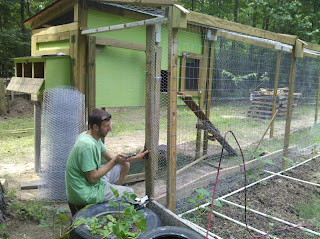I have had more than one person tell me that they would love to compost, but thought it sounded too complicated. So instead, they just threw away all of their food waste and other compost materials.
Well, I'm here to tell you that anyone, anywhere can compost!
A passive compost pile is easy, and even if you do it 'wrong', it is much better than sending that organic material to the landfill! It is better for the environment, your garden, AND your wallet (why buy compost when you can make it yourself?).
Where to compost:
When picking a location to compost, keep in mind that you will be visiting this pile fairly frequently. You want it to be somewhere convenient, but preferably not too close to the door/house (the pile may not be pretty!).
 |
| Use wood pallets to make composter |
You can buy a fancy composter at a hardware store, or you can make your own out of pretty much anything. For example, I attached 3 old pallets together. Or you can just make a pile in your yard, without any containment. If you don't have a yard, you can compost in a tub under your sink. With compost, the possibilities are endless.
 |
| Composter made out of wood pallets |
After you pick where you will compost, you just add compostable materials to it.
Anything that you would consider biodegradable can probably be composted.
What to compost:
- Brown yard waste (dried leaves, pine straw, twigs, etc.)
- Green yard waste (grass clippings, pulled vegetable plants, etc.)
- Kitchen waste (vegetable scraps, eggshells, coffee and tea grounds)
- Household waste (tissues, scrap paper, newspaper, toilet paper rolls, etc.)
- Livestock manure (from chickens, cows, pigs, goats, etc.)
What NOT to compost:
- Animal products (meat, fat, dairy)
- Human or pet feces
How I compost:
To make collecting compost easier, you can keep a container with a lid in the kitchen, specifically for compost. If flies become a problem, you can keep the container in the freezer. I just bring out the container, add the vegetable scraps to it as I cook, then put it back in the freezer. Once it is full, I take the compost container outside and empty it into the big pile. I then add a few handfuls of dried leaves on top.
Dried leaves are always a great addition after adding kitchen scraps!
Any garden or yard waste also goes into the compost pile: dead plants, no longer productive vegetables, fallen leaves, etc.
The pile can be turned (mixed up) every few days, every month, or never. The more you turn it, the faster it will compost, but it will all eventually compost even if you don't turn it.
And that's it! Once you learn what can be composted, and get in the habit, it's actually quite easy.
For more information on compost, the NC State horticultural department has a great publication
here.
Hot compost
The complication in composting comes with getting the ratios of carbon and nitrogen correct, and maintaining the correct moisture level, in HOT composting. Ideally, with the right conditions, the compost pile will heat up enough to kill weed seeds, pests, and disease; and it composts REALLY fast. But slow compost is better than no compost! So if you don't have the time to research hot composting, don't worry about it.







































